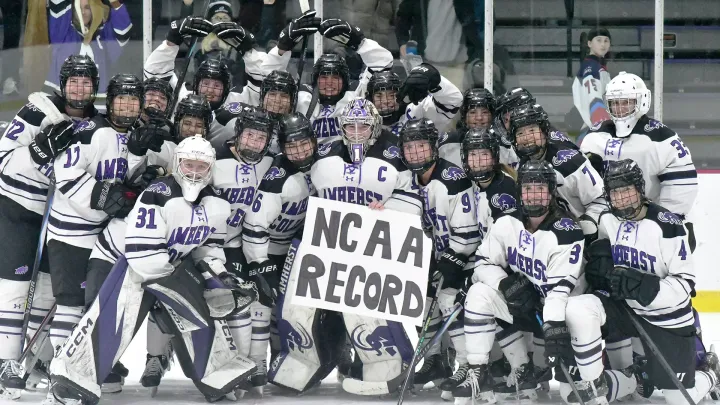D-Wade’s Divine Comedy and the Nameless, Faceless Man
Assistant Sports Editor Toby Rosewater ’28 reflects on Dwayne Wade's new statue and embarks on a journey to basketball Heaven.

Twenty thousand spectators watch a nameless, faceless man in a sleeveless jersey leap into the air. He is alone. For a moment, he levitates, extending his arms as if he were Adam, the first man, desperately reaching for God’s divine hand. The amazed crowd watches as the man, all in one motion, reels in his outstretched arms, clutches his hands together, and pins them tight to his chest. When he finally descends, the crowd roars. He looks around, gathers himself, and, without hesitation, dashes across the arena.
Such is basketball without context. It is a bizarre scene. A nameless, faceless man frolics for no ball. He jumps, contorts, and twists for not. It is a scene devoid of insignia, meaning, a task, an opponent, and a goal. Absent of substance, only spectacle remains. It is strange; the crowd’s roar is unsettling, and the man’s unexplained, disordered movements conjure, at best, fleeting moments of grace and, at worst, distorted human form.
Now, let’s name this player — distinguish him — and put a face to the name. Stands overflow as people clamor to see “Toby” move around the court. He sells out arenas in Boston, New York, D.C., LA, you name it. If “Toby” is running, jumping, circling, and contorting, people will pay to see it. This time, the whole thing turns into an extreme form of hero worship. People come to the arena with “Toby’s” face on their shirts; they take videos of him and post them online for hundreds, if not thousands, if not millions, to see. “Toby,” for all intents and purposes, becomes a figure of worship, an inhuman spectacle devoid of real context.
While this situation may sound outlandish, it is not all that far from the truth. Just a few weeks ago, the Miami Heat unveiled a permanent statue of NBA Hall of Famer Dwayne Wade in front of their home arena. The public’s response was overwhelmingly negative. It hardly looks like Wade. For instance, the statue’s jaw extends downward and outward, creating a lethargic musculature that clashes with Wade’s lean, athletic features. Whoever’s face the statue wears — perhaps David Hasselhoff’s, Antoine Walker’s, or both — it is certainly not Wade’s. To make matters worse, Wade, who provided feedback throughout construction, has repeatedly praised the statue with a fervent, almost inauthentic zeal. His defense is so vapid — so unconvincing — that it almost fails to make sense. “If I wanted it to look like me,” Wade said, “I’d just stand outside the arena, and y’all [could] take photos … It don’t need to look like me. It’s the artistic version of a moment that happened.” Days later, Wade elaborated further, defending the statue and arguing that it depicts more than just a human body. In a sense, then, it showcases a higher form. In fact, in his opinion, it is “art at its finest.” Essentially, Wade believes that he is not just any other basketball player but “the chosen one.”
This rhetoric, while obviously self-congratulatory, reveals a piercing irony. The statue intended to honor Wade’s greatness fails to capture his essence, both physically and contextually. It lacks a ball, a teammate, a hoop, a net, and a score. It reduces a complex narrative to a static symbol of greatness — a monument that fails to convey the richness of a human story. It exists in a purgatory between nameless, faceless basketball Hell and real, meaningful basketball Heaven. In a way, it is “Toby” running, jumping, circling, and contorting. In real life, though, greatness requires context; it is a byproduct of context. Without substance, greatness is nullified. In turn, by isolating greatness, the statue not only renders the term meaningless but Wade inhuman.
Alas, the statue is a far cry from basketball Heaven — actual basketball. It tries to depict Wade’s iconic “This is my house!” celebration from a home game against the Chicago Bulls in 2009. The game was tied in double overtime with nine seconds to go when Wade stole the ball off John Salmons and dashed down the court to hit a game-winning three at the buzzer. Wade, often called the “Flash,” ran in his satin black jersey as a thousand flashbulbs lit his path. If it is possible for an athlete to ever actually be “great” — to embody the expectations that come with “greatness,” then maybe — just maybe — Wade does it here. With two seconds left, he shot a moving, one-legged off-balance three for the win. He finished the game with 48 points, 12 assists, four steals, and three blocks. Afterward, he jumped on the scorer’s table, pointed downward, and repeatedly shouted, “This is my house!” A moment of euphoria — basketball Heaven — the crowd erupted in thunderous applause, and this time, they cheered for a reason.




Comments ()